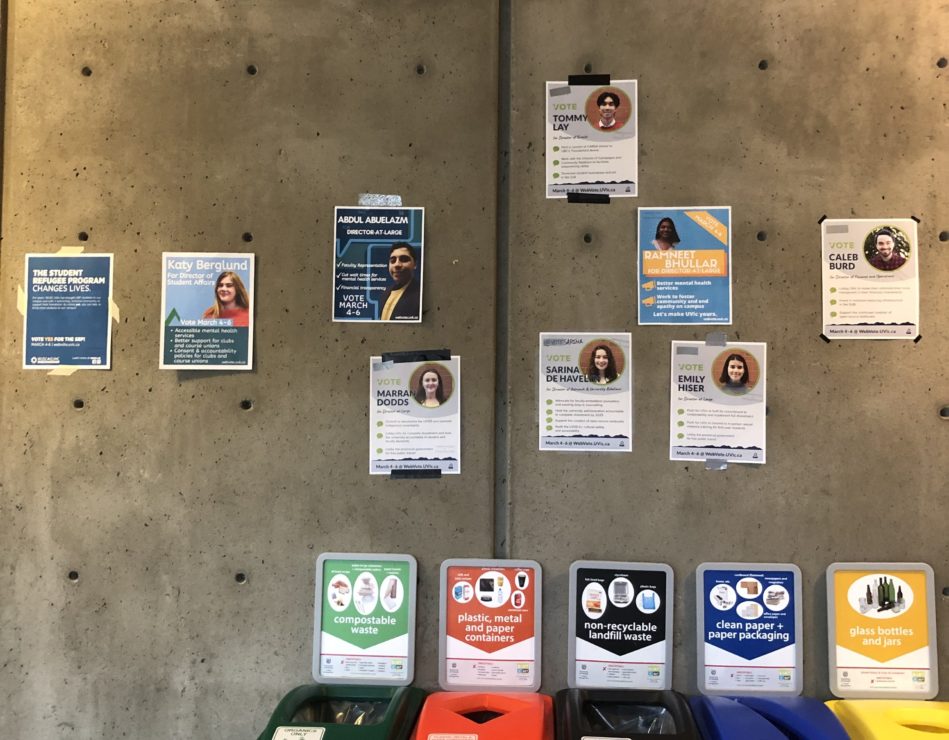UVSS Candidates’ focus on Social Science students leads to greater disengagement

At the start of this month, you participated in the democratic institution that is the UVSS and voted on the next year’s Board of Directors. Or maybe you didn’t. 15 551 of you didn’t. And if you aren’t in Social Sciences, I’d bet it’s even more likely that you were among those over 15 thousand people, and I don’t blame you.
On March 5, in the middle of the election period, I noticed something when going between my social sciences and fine arts courses: the candidates’ posters that I would see everywhere around me in the David Turpin building (home to many of the Social Sciences faculties) seemed to disappear as I got closer to the Fine Arts building. So just to be sure, I counted them.
In the main 100- and 200-levels of the David Turpin building and on the exterior, there were 60 posters up, including multiple large billboard-style posters, not to mention the chalking of most free sidewalk and wall space outside. In the Fine Arts Building (both floors) and the Phoenix Theatre building, there was a combined six posters up, and minimal chalking.
Now, I don’t want to immediately suggest that this is the reason for low engagement. It makes sense that buildings inside Ring Road would be more heavily postered and chalked, as those areas have higher foot traffic, and posters will be seen by more students. The Fine Arts buildings are outside of the ring, away from the crowds, and honestly a long walk away from the SUB. But 60 to six seems pretty significant.
Speaking to friends I know in varying faculties, it seemed a common trend that people in social sciences, especially political science, would have seen Board of Directors candidates’ posters, had candidates do classroom talks, and even interacted with candidates directly. Yet for people outside of social sciences, this was less likely. Especially in fine arts, many friends I spoke to couldn’t remember ever having a candidate come talk to their class in the years they’d been at UVic, let alone personally interact with them. As a political science major and writing minor, only one of my five classes this semester is in social sciences — coincidentally (or maybe not) it was the only class where we had a candidate come speak to us.
Now, this isn’t an attack on the UVSS board and this year’s candidates. Many of them had strong social media campaigns that engaged with students all over campus. It also makes sense that many candidates would target voters in social sciences, especially political science, as many of them are themselves students of social sciences, as are their campaign team members, friends, and classmates. Especially for political science students, UVSS elections are what mono is for first-years in residence — everyone knows someone involved in it.
If prospective candidates for the UVSS are engaging less with students outside of social sciences, I don’t think we can fully blame those students for then not participating in UVSS elections, meetings, or committees. In a 2015 report from the Samara Centre for Democracy looking at youth engagement in Canadian politics, one of the biggest determinants of youth turnout was if they had contact with a candidate or party; if they had contact, they were more likely to vote and feel that their political decisions matter. The majority of youth voters had not been contacted by a politician or candidate, and thus felt ignored by parties and did not engage in formal politics. Based on voter turnout and engagement at election debate and forum events, it appears that this trend may also be the case with those who don’t vote in UVSS elections.
Voter engagement and student involvement in the UVSS is clearly chronically lacking the voices of many faculties and students. Many candidates spoke of this in their campaigns this year, and had promising ideas of how to increase student involvement. Though voter turnout didn’t break 15 per cent in the election, the new UVSS board’s work will soon be underway in May. As the new board takes on their roles in the coming months, I hope they work to engage with students from every faculty, so their events, meetings, and committees are attended by more than just their social (science) groups.








